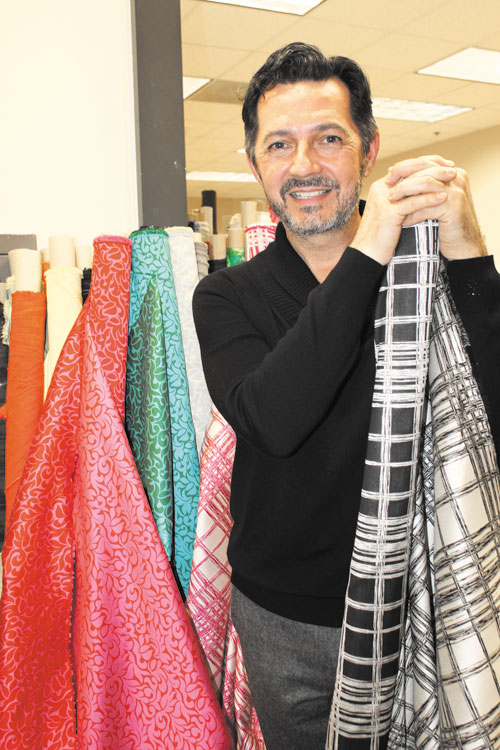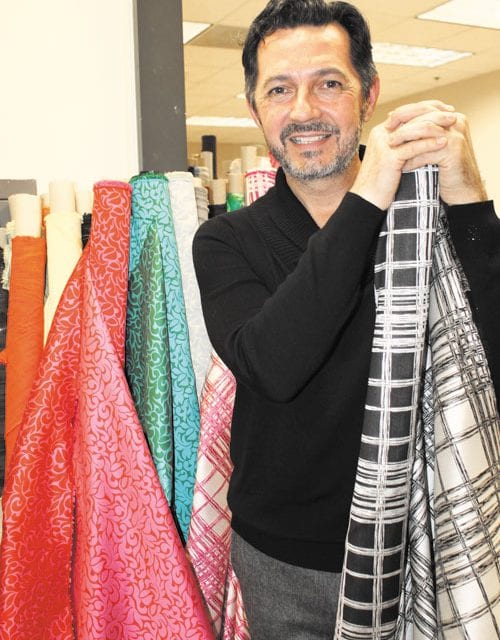 ARNOLD WAYNE JONES | Executive Editor
ARNOLD WAYNE JONES | Executive Editor
One of the great traditions in Dallas — as with all good gay traditions of the last 30 years — started with Madonna.
It was 1988, in the infancy of DIFFA Dallas — the Design Industries Foundation Fighting AIDS, a fundraising organization in the early, deadliest years of HIV — and Michael Faircloth was participating. The origin of the event wasn’t fashion-based but interior design-based; Faircloth, just a few years out of college and a dress designer still trying to make his reputation, was donating a dress for the auction.
Because decorators instigated the show, Faircloth used fabrics intended more for curtains than cuffs, like the several other dressmakers participating.
The runway didn’t go well.
“It was not a successful auction,” concedes Faircloth, now one of Dallas’ best-known designers (He famously made the scarlet-red inauguration gown Laura Bush wore in 2001). “There were maybe 150 people. No one could afford these size 2 dresses!”
But Faircloth, his then-wife Donna and his soon-to-be (and still-is) partner David Davis, refused to give up on the idea of fashionistas fundraising for AIDS. The three were sitting around brainstorming when one of them noticed a fashion magazine that had a picture of Madonna at a trendy event, wearing an extravagantly restyled denim jacket.
Light bulb.
“The Levi’s denim jacket was the perfect canvas. We knew we could elevate the classic piece of Americana into something fabulous,” Faircloth says. “We came up with the idea of approaching Levi Strauss to see if they would donate 100 denim jackets. Then we would use our connections at Neiman-Marcus to get the jackets [circulated among] designers around the country.”
They had no prior relationship with anyone at Levi’s, but that didn’t stop them. The iconic brand was (and is) based in San Francisco, where AIDS wreaked the most devastation.
Davis flew there on the errand of mercy with high hopes. Still, even they were surprised and delighted that Levi’s quickly agreed.
“They were very excited. The hardest part was coordinating [delivery] of the jackets to very high-profile designers of the time,” Faircloth says.
Faircloth won’t even speculate about what would have happened if Levi’s had said no. Having Levi’s stamp of approval at a time when HIV was not something the rich and powerful cared to acknowledge, much less discuss openly, was just one vital step that helped transform a community benefit into one of the preeminent HIV/AIDS fundraisers.
For two decades “the Dallas Collection” was synonymous with repurposed jeanswear — not in Size 2s, not even exclusively for women, but a panoply of celebrity-designed coats and eveningwear that made DIFFA a brand of Dallas, eventually reaching around the nation.
Faircloth still remembers virtually every jacket he designed: “I tried to make them extraordinary, with hand beading and embroidery, and exotic fabrics and skins — I’m in a luxurious industry, and we wanted to bring luxury to the [runway],” he says.
He even recalls that his first jacket was bought at auction by Joe Pacetti, who is being honored at House of DIFFA this year as one of the Legends of Style.
“I remember the incredible talent and art of design that Michael possessed and does still possess,” Pacetti recalls. “Those denim jackets were the real start of people being made aware of DIFFA and the awareness of AIDS. Prices were minimal then and fortunately have risen over the years to benefit the cause.”
(Back then, it was just the clothes themselves that raised the money; there weren’t “packages” — airline tickets, weeks in Italian villas, etc. — to nudge the sales along.)
“I believe I have purchased 19 jackets over the years, and have gifted every single one on the condition that when they wear the jacket, they spread the word about DIFFA,” Pacetti says.
The system worked. Dallas’ DIFFA event is still the best-known … as it was always destined to be.
“Even after that first show, I had no doubt we would make it work — we had to make it work,” Faircloth says. “We knew we would make it the biggest and the best.”
In some ways, they had to. In the 1980s and early ’90s, being diagnosed as HIV-positive was practically a death sentence. Faircloth and countless others saw too many friends to count succumb to the ravages of the disease.
Yet there was much misinformation and fear, and not enough money allocated to help those in need — not even to find a cure, but just to make their lives bearable.
“Dallas was a conservative city in a conservative state. To get people to donate money or to help out was hard,” Faircloth reflects. “We were raising money to improve the quality of life [of people with AIDS] — we weren’t really saving lives. The first three or four years, I was having to explain to my clients not just what DIFFA was, but that AIDS was the need for it. Now, Dallas is the ‘city of charities’ and DIFFA — and AIDS — is common knowledge and we have elevated the event to a tremendous level.”
A tremendous level, indeed.
On Saturday, again at the Omni Downtown, DIFFA returns for its 25th Collection (no event was held in 1993, 1999 or 2010) … and there will be a sight more than 150 people in attendance. It has become one of the pre-eminent social and fundraising galas the city hosts each year: 1,500 people are expected to attend the sold-out party, which over the years has raised more than $6 million in support of people with HIV/AIDS.
But all things come to an end … or at least take a break. Faircloth made “between eight and ten” jackets before “taking a little hiatus” from DIFFA. In the early days, he said, he had more time than money to donate; in later years, the reverse was true.
But DIFFA has always remained dear to his heart, as it has for so many in the community. On Saturday, Faircloth will return in person for only the second time in a decade. And he’ll see his latest creation — a handmade zebra jacket fashioned from a custom-woven fabric from Barcelona he had specially commissioned — walk the runway for charity.
“It has a strong graphic element — very black-and-white,” he explains. “I’m very rules-oriented that way. And it has very exaggerated black fox cuffs.”
And there’s not a lick of denim to be seen.
That’s because, as successful as the denim collection proved to be, DIFFA changed direction a few years ago. They started by opening up the fashions to smoking jackets; last year’s event enticed with the theme “masquerade.”
This year? Well, it’s the silver jubilee — anything goes.
“[The past few years] have shown a whole new chapter in the Dallas Collection,” Faircloth says. “I went to [the 2014] event at the Omni, and it was a spectacular show — must different than our first show at the InfoMart, which was still quite new [then]. Then, they just set up bleachers in the main hall and these models from Kim Dawson just walked down the middle. Now it’s just humongous, and to see how much awareness it brings to HIV is gratifying.”
House of DIFFA, Omni Dallas Downtown, 555 S. Lamar St. Doors at 6 p.m. Individual tickets ($350) may still be available. Overnight rooms at the hotel start at discounted level of $199. DIFFADallas.org.
………………………
Legends
DIFFA/Dallas’ 2105 Style Council Ambassadors for 2015 are Jenn Clark, Ralph Randall, Debra Nelson, Norma Johnson, Patrick Ware, Scott Ken, Shayne Robinson, Jody Stein and Jenna Alexander
DIFFA/Dallas’ Legends of Style — some of the most successful and influential past Style Council Ambassadors brought back this year to help commemorate the 25th DIFFA/Dallas gala — are Simona Beal, Don Gaiser, Rebecca Hallam, Gillian Breidenbach, Joe Pacetti, David Kiger and Matrice Kirk.
The Style Council Ambassadors and Legends of Style were introduced last October in a reception at Neiman Marcus Downtown. Both Style Council Ambassadors and Legends of Style represent DIFFA/Dallas as ambassadors to the community for the 2014-2015 season. They help raise awareness about the organization and continue efforts to educate people about HIV/AIDS and prevent spread of the disease.
This article appeared in the Dallas Voice print edition March 6, 2015.
DIFFA @ 25


